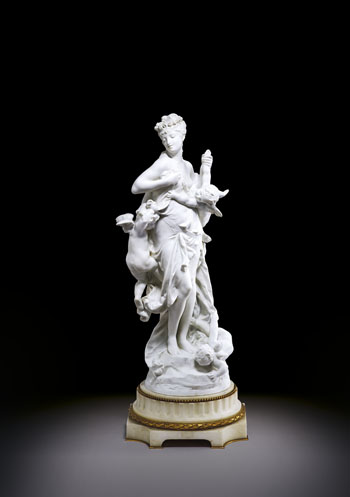PROVENANCE:
Galerie Giroux, Brussels, Belgium (before 1940)
Private collection, Belgium
ILLUSTRATED:
Sander Pierron, Francois Rude et Auguste Rodin à Bruxelles, La Grande Revue, Paris, 1902,
pp. 138–62
Vers l’Age d’airain: Rodin en Belgique, Musée Rodin, Paris, 1997, pp. 109–110 (another proof ill.)
Rodin, les arts décoratifs, Musée Rodin, Paris, 2010, pp. 15, 22, 23 (another proof ill.)
This work will be included in the forthcoming Catalogue Critique de l'Oeuvre Sculpté d'Auguste Rodin currently being prepared by the Comité Rodin under the archive number 2009-3981B.
Catalogue Note:
One of the most recognizable Modern European sculptors, Rodin spent an early portion of his career as a collaborator in the studios of other well-known and established artists. From 1870 until 1872, Rodin lived in Brussels, where his main employer was Eugène Albert Carrier-Belleuse, a sculptor whose decorative busts and figural groups—which recalled the 18th century Rococco master Clodion—were highly sought after.
While creating several important works during his period in Belgium, Rodin was unable to sign his name to his sculptures, as his official position under Carrier-Belleuse restricted his ability to claim works as his own. His major work as Carrier-Belleuse's assistant includes the Vase of the Titans; a group of 4 stately giants from Greek mythology inspired by Renaissance master Michelangelo, the work still carries the signature of Carrier-Belleuse despite having been designed by Rodin. The current lot, Innocence tormented by Love, is now considered in a similar light. Although bearing the signature of Carrier-Belleuse, this sculpture serves as an example of collaborative work, with the design and modeling completed by Rodin. This attribution dates back to the Belgian writer Sander Pierron’s 1902 article on Rodin, and as such Innocence tormented by Love can be seen as an important step in the artistic development of Rodin.
Carrier-Belleuse edited this work with the Compagnie des Bronzes de Bruxelles, who produced an edition the size of which is not yet known. The Compagnie produced examples in terracotta, marble, biscuit de Sèvres, and bronze, each in varying sizes, the last of which is dated circa 1910. Innocence tormented by Love presents a work which exhibits the qualities deemed characteristic of the Compagnie’s efforts in biscuit de Sèvres, and dates before 1910. Well documented in literature as a work by Rodin, the Rodin Museum holds a single copy in collections exhibited as Rodin and Carrier-Belleuse.
A popular theme in late 19th century France, Innocence tormented by Love depicts a scene in which cherubim encourage a young woman into sexual awakening.
